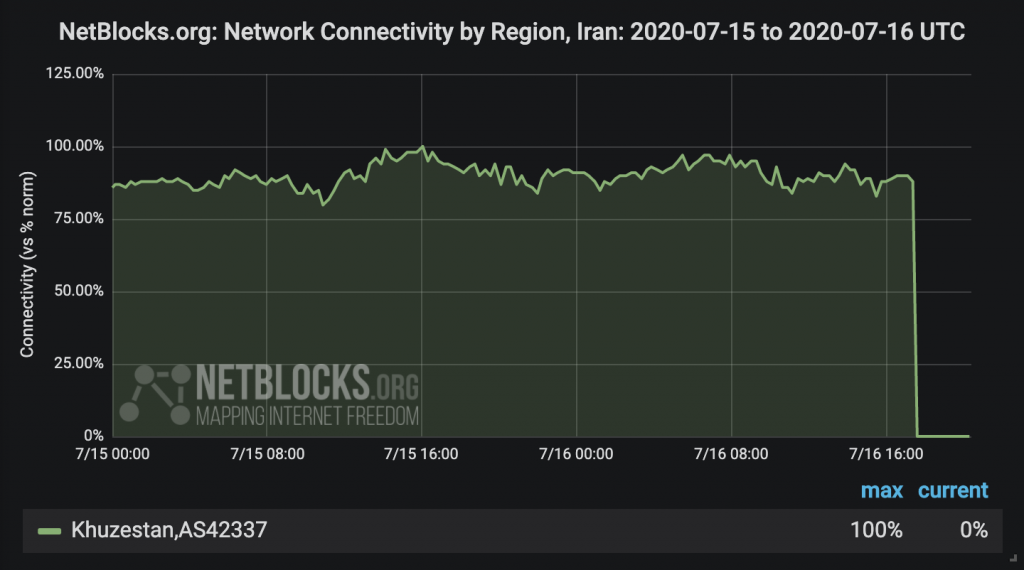Network data from the NetBlocks internet observatory have identified internet restrictions in Khuzestan Province, southwest Iran from 10:00 p.m. local time Thursday 16 July 2020. The incident was registered as authorities dispatched security forces in response to regional anti-government rallies.
What’s behind Iran’s internet disruptions?
Internet restrictions with regional effect have been registered by the Internet Observatory in Khuzestan Province, southwest Iran from 10 p.m. local time. Verified user reports also indicate disruption to cellular networks further afield. Demonstrations are taking place in Behbahan, Khuzestan with slogans critical of Iranian foreign policy and the economic crisis. In recent days, many Iranians have spoken out against the death penalty following the sentencing of youths who participated in the November 2019 protests.
Confirmed: Internet restrictions are in place in #Khuzestan Province, southwest #Iran from 10 p.m. local time; real-time network data show total (pictured) and partial disruptions varying by provider amid anti-government protests; incident ongoing #IranProtests ? pic.twitter.com/UzhsERVj5i
— NetBlocks (@netblocks) July 16, 2020
Disruptions identified on Thursday affect connectivity at the network layer and cannot easily be worked around by users. Hence, they are likely to limit coverage of incidents as they take place.
Earlier in the week Tuesday 14 July 2020, multiple networks were disrupted for approximately three hours while users reported slow or unusable internet. The disruption occurred as hashtags calling on Iranian authorities to halt executions trended globally on social media.
Update: Yesterday's internet disruption in #Iran had partial impact, reducing service quality for ~3 hours on multiple providers while the hashtag #اعدام_نکنید (don't execute) trended on social media #️⃣ pic.twitter.com/zS8kYIN80H
— NetBlocks (@netblocks) July 15, 2020
On Saturday 18 July, compounding the impact of Iran’s network disruptions, Khuzestan’s governorate announced a three-day lockdown of 22 cities and towns in the province including Behbahan citing previously unreported claims of a 100-fold rise in COVID-19 infections.
Recent disruptions and shutdowns
Iran has faced a series of network disruptions in recent months, with some attributed to external factors, and others to state information controls or targeted internet shutdowns. NetBlocks investigations have helped identify the root causes of these network outages.
In November 2019, Iran deliberately shut down internet access amid widespread public protests. While the shutdown started as a total outage, users gradually regained access as connectivity was selectively brought back after a week.
Update: It's midday in #Iran where technically inclined users have been finding their way online through the #filternet this morning.
National connectivity remains at just 22% but real-time network data show coverage has increased ?#Internet4Iran
?https://t.co/1Al0DT8an1 pic.twitter.com/M0yzprwL5v
— NetBlocks (@netblocks) November 23, 2019
On 8 February 2020 internet access was cut in Iran as a response to a cyber-attack after authorities activated what they described as the “Digital Fortress” isolation mechanism.
Confirmed: Internet partially shut down #Iran from 11:45 a.m. local time (08:15 UTC); real-time network data show national connectivity fall to 75% after authorities reportedly activated "Digital Fortress" isolation mechanism; incident ongoing ?
? https://t.co/Qb8bxYUT71 pic.twitter.com/bsETg1Sfxb
— NetBlocks (@netblocks) February 8, 2020
Other disruptions are caused by international connectivity failures, with one recent incident traced to power fluctuations and outages in neighboring Armenia:
Report: Internet in #Iran disrupted due to knock-on effect of power cut in #Armenia
Analysis of network data reveals how a series of unlikely events on Wednesday led to filternet-like internet outages that users could circumvent with a VPN ?
— NetBlocks (@netblocks) July 8, 2020
NetBlocks recommends against the use of network disruptions to limit the rights to free expression and free assembly.
Further reading
- Iran security forces fire tear gas to disperse protesters – Reuters
- Internet disrupted in Iran province as police disperse rally – The Associated Press
- Protest rally in Behbahan despite intense security presence – BBC
- Interruptions to Internet access in province of Iran – TASS
- Internet Access Disrupted In Iran As Uproar Rises Against Executions – Radio Farda
- Why Iranians are rallying online to stop the execution of three protesters – The Washington Post
- In Iran, Rare Protests (Online) Against Capital Punishment – The New York Times
- Iran Throttles Internet After Anti-Execution Hashtag Goes Viral – Newsweek
- Iranians take social media by storm to halt executions – Al Jazeera
- Iran death penalty verdict for young protesters sparks social media outrage – Deutsche Welle
- Unprecedented mobilization against death penalty in Iran – Radio France Internationale
Methodology
NetBlocks diffscans, which map the IP address space of a country in real time, show internet connectivity levels and corresponding outages. Purposeful internet outages may have a distinct network pattern used by NetBlocks to determine and attribute the root cause of an outage, a process known as attribution which follows detection and classification stages.
A summary of data visualizations used in this report:
- Network Connectivity (Regional): Selected internet providers and networks geolocated to their approximate region are visualized in a stacked time-series chart to identify the start and end times of an internet outage event. Scales on the y-axis are adjusted to match localized maxima while minima are scaled to 0 indicate periods when networks became unreachable. The x-axis represents Universal Coordinated time (GMT+0). Connectivity levels on the y-axis correspond to the observed number of reachable connections.
-
- Standard: Connectivity levels on the y-axis correspond directly to the observed number of reachable connections, as with National Connectivity charts.
NetBlocks is an internet monitor working at the intersection of digital rights, cyber-security and internet governance. Independent and non-partisan, NetBlocks strives to deliver a fair and inclusive digital future for all.
[ press | contact ] Graphics and visualizations are provided for fair use in unaltered form reflecting the meaning and intent in which they were published, with clear credit and source attribution to NetBlocks. Intellectual property rights are protected including but not limited to key findings, facts and figures, trademarks, copyrights, and original reporting, are held by NetBlocks. Citation and source attribution are required at the point of use.

